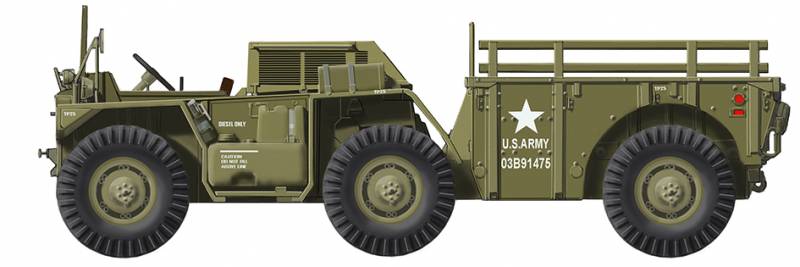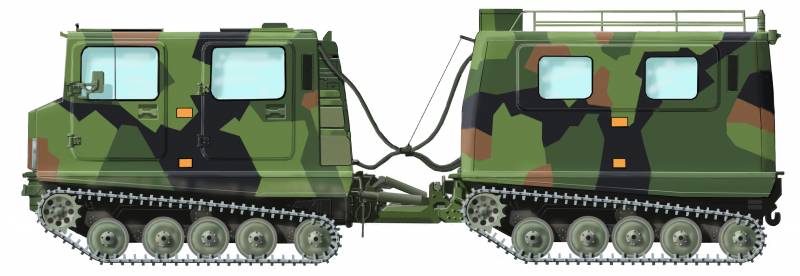Articulated armored vehicles

Combat tandem: combat wheeled vehicle, consisting of two modules. The front module houses the engine and armament. In the second - also an engine, but of less power, a compartment for troops and a ZSU installation. Such a project was developed in France, but was not approved.
First Corinthians 12:26
Tank panopticon. And it happened that back in 1997 and 1998, the Military Parade magazine published material by V. Batenin, V. Kovalev and M. Starostin, named representatives of the Academy of Armored Forces, about a fundamentally new approach to creating tanks of the XNUMXst century. What interesting things did they offer, such that it was possible to paint in as many as three materials? And they proposed a new approach to the design of armored vehicles, which, in their opinion, is capable of taking our tanks completely apart from what our potential opponents have.
The concept - "all units and crew in one building", in the opinion of the authors of this series of articles, is outdated and does not provide an opportunity to create new and perfect tanks. They say that more and more new and complex systems are being introduced into the design of tanks, the caliber of the gun is increasing, armor protection is growing, and accordingly, the power of the tank engine is increasing. But ... everything in the world has a limit. Tanks are getting heavier and heavier. Free reserved space is also decreasing all the time, which reduces the comfort of the crew.
As a result, the crew cannot realize more than 70% of the potential capabilities of the tank. And traditional layout solutions do not make it possible to significantly increase its performance characteristics. It is required to reach a new, higher level of efficiency - and how to do this if, in fact, all the possibilities for improving tanks with the traditional approach to their design have been exhausted?

M561 - American articulated off-road vehicle "Gama Goat" with six-wheel drive
First of all, we are talking about a system-forming approach to the creation of new machines. That is, what we are seeing today - the former diversity (T-62, T-64, T-72, T-80, T-90) simply should not be in the army. There should be a single platform for a whole family of combat vehicles. Moreover, in addition to combat vehicles, they also need support vehicles, which will allow tank units to operate in isolation from the main forces. Such “nepotism” can only be welcomed, but so far we have not reached the level of constructive thinking. That is, everyone understands this, they write and talk about it (and not only the authors of articles in the indicated journal), but the various machines are still winning.

The UDES-XX20 is a Swedish light tank, often referred to as a two-section self-propelled anti-tank gun. It was developed back in 1977-1982 by Hägglunds. The prototype of the machine was made in a single copy, it was highly appreciated during the tests, but was not accepted into mass production. Now located at the Swedish Army Museum in Stockholm
In general, the authors propose to move from traditional single-hull vehicles to multi-hull, articulated combat vehicles. They even came up with an abbreviation for them, but it is too long and difficult to pronounce to be given here. Anyway, no normal person will remember so many consonant letters in a row. But the idea itself is interesting and quite worthy of our tank panopticon, where, as VO readers, of course, they remember what is not there.
In short, the authors propose a three-membered machine. Consisting not even of two, but of three modules. Moreover, all three modules can be decoupled from each other and act independently.
The authors see the benefits as follows: each module can have an increased quality due to the design separately. That is, three perfections are combined into one, which is why the final perfection becomes ... even more perfect.
The main combat characteristics of the tank are shared, which is regarded as a positive fact. That is, when all three modules are connected together, then this is ... a tank! But now the transport and evacuation module is separated from it and is engaged in delivering fuel and ammunition to the two remaining modules. Both mobile modules unhooked from the combat module and ... “left on business”, and the combat module fires from the ground as a stationary artillery mount. Then two transport modules again dock with the combat one and take it to the right place. This is convenient, since today tank units are served by a large number of wheeled vehicles that are not armored and have limited terrain.
As an example, the authors point to the modern use of tanks in Bosnia, where they were used, as a rule, as self-propelled guns, and artillery was used stationary.
It is emphasized that a "promising" articulated tank should consist of three modules: combat and two transport and evacuation. The combat module is hinged between the transport and evacuation modules. Hinges provide mobility to the system and the ability to connect and disconnect. Accordingly, the weapon station has hydraulic jacks that raise or lower the module when it is articulated or disengaged from the two modules. Interestingly, the presence of jacks is also capable, according to the authors, to increase the firepower of the tank. How? And it’s very simple - to raise the warhead of the tank so that it can “see further”, fire a shot, and then “crouch” on the ground in order to sharply lower its height and at the same time reduce visibility.

Successful development of the Swedes: BV-206 "Moose" - an articulated tracked all-terrain vehicle, consisting of two modules. It was developed in 1974 by the Swedish company Hägglunds. More than 11 machines have been produced and delivered to more than 000 countries around the world
The combat module is also equipped with a turret with a gun, and the main crew is also located there, and engines, transmissions and driver positions are located in the transport and evacuation modules. Here, I must say, the authors of the project return to the idea of the 20s, when a second aft post with steering was installed on combat vehicles, which allowed such BAs (and they were equipped with BAs, but not tanks) quickly, and at the same time without turning around, leave the battlefield.
That is, the rectilinear movement of such an articulated tank occurs according to the “push-pull” principle, and if the propulsion system of the front module is affected, then the tank leaves the battle due to the work of the rear, and besides, you can move forward and backward at the same speed, which is what our modern tanks can't.
It is interesting that the turn of such a machine is possible in two ways - "in a tank way", that is, due to the work of the tracks, and "in a car way", due to the rotation of each individual module relative to the combat one.

T-80BV with mounted modules for transporting cargo and infantry
Also, three modules can give the system more security. Two modules in front and behind provide high security to the combat module, just as the engine and transmission of the Merkava tank, placed in front, increase the security of its crew. And then there are two engines at once and the corresponding armor protection, both in front and behind, so you won’t get to the body of the combat module itself, except perhaps from the side.
Cross-country ability increases - an articulated vehicle has a higher clearance, maintainability increases - due to the “cannibalism” of wrecked vehicles, because if we have two tanks with damaged transport modules, then it doesn’t cost us anything to combine them into one whole tank, and without any problems.

Articulated three-section tank, which is discussed in this material
In a word, according to the authors of all these materials, all the benefits are obvious. About the "disadvantages" is not written, but they certainly exist. As you know, it is very difficult to do simply, but it is very easy to do difficult. In this case, we have very complex hinge joints for connecting modules, which will have to have great strength, and hence a lot of weight. And the weight at the same time will not affect the security of this machine. A breakdown of such a node on one module, and anything can break, for some time will disable such a tank completely. Because he will not be able to ride on one module, and he will need to look somewhere for a second module from a damaged car, which may not be at hand.
The tank acquires large dimensions and heavy weight, which can negate all the advantages of its increased maneuverability. Its security from the sides also decreases. On modern tanks, the turret compartment is more or less covered by wheels and tracks. On an articulated tank, the side projections of the turret box are open for destruction. In a word, there have always been more interesting ideas in the field of tank design than their implementation, and not everything that looks good on paper looks just as good in metal! But as gymnastics for the mind... why not?!
The article used materials from the magazine "Military Parade" No. 3 and No. 4 for 1997, No. 2 and No. 6 for 1998.
Fig. A. Shepsa.
Information